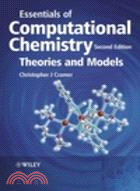Essentials Of Computational Chemistry - Theories And Models 2E
商品資訊
ISBN13:9780470091821
出版社:John Wiley & Sons Inc
作者:Cramer
出版日:2004/09/24
裝訂/頁數:平裝/624頁
規格:23.5cm*16.5cm*3.8cm (高/寬/厚)
商品簡介
作者簡介
目次
相關商品
商品簡介
Essentials of Computational Chemistry provides a balanced introduction to this dynamic subject. Suitable for both experimentalists and theorists, a wide range of samples and applications are included drawn from all key areas. The book carefully leads the reader thorough the necessary equations providing information explanations and reasoning where necessary and firmly placing each equation in context.
作者簡介
Christopher Cramer, Professor of Computational Chemistry Department of Chemistry, University of Minnesota,Minneapolis, USA
目次
Preface to the First Edition.
Preface to the Second Edition.
Acknowledgments.
1. What are Theory, Computation, and Modeling?
1.1 Definition of Terms.
1.2 Quantum Mechanics.
1.3 Computable Quantities.
1.3.1 Structure.
1.3.2 Potential Energy Surfaces.
1.3.3 Chemical Properties.
1.4 Cost and Efficiency.
1.4.1 Intrinsic Value.
1.4.2 Hardware and Software.
1.4.3 Algorithms.
1.5 Note on Units.
Bibliography and Suggested Additional Reading.
References.
2..
Molecular Mechanics.
2.1 History and Fundamental Assumptions.
2.2 Potential Energy Functional Forms.
2.2.1 Bond Stretching.
2.2.2 Valence Angle Bending.
2.2.3 Torsions.
2.2.4 van der Waals Interactions.
2.2.5 Electrostatic Interactions.
2.2.6 Cross Terms and Additional Non-bonded Terms.
2.2.7 Parameterization Strategies.
2.3 Force-field Energies and Thermodynamics.
2.4 Geometry Optimization.
2.4.1 Optimization Algorithms.
2.4.2 Optimization Aspects Specific to Force Fields.
2.5 Menagerie of Modern Force Fields.
2.5.1 Available Force Fields.
2.5.2 Validation.
2.6 Force Fields and Docking.
2.7 Case Study: (2R*,4S*)-1-Hydroxy-2,4-dimethylhex-5-ene.
Bibliography and Suggested Additional Reading.
References.
3. Simulations of Molecular Ensembles.
3.1 Relationship Between MM Optima and Real Systems.
3.2 Phase Space and Trajectories.
3.2.1 Properties as Ensemble Averages.
3.2.2 Properties as Time Averages of Trajectories.
3.3 Molecular Dynamics.
3.3.1 Harmonic Oscillator Trajectories.
3.3.2 Non-analytical Systems.
3.3.3 Practical Issues in Propagation.
3.3.4 Stochastic Dynamics.
3.4 Monte Carlo.
3.4.1 Manipulation of Phase-space Integrals.
3.4.2 Metropolis Sampling.
3.5 Ensemble and Dynamical Property Examples.
3.6 Key Details in Formalism.
3.6.1 Cutoffs and Boundary Conditions.
3.6.2 Polarization.
3.6.3 Control of System Variables.
3.6.4 Simulation Convergence.
3.6.5 The Multiple Minima Problem.
3.7 Force Field Performance in Simulations.
3.8 Case Study: Silica Sodalite.
Bibliography and Suggested Additional Reading.
References.
4. Foundations of Molecular Orbital Theory.
4.1 Quantum Mechanics and the Wave Function.
4.2 The Hamiltonian Operator.
4.2.1 General Features.
4.2.2 The Variational Principle.
4.2.3 The Born-Oppenheimer Approximation.
4.3 Construction of Trial Wave Functions.
4.3.1 The LCAO Basis Set Approach.
4.3.2 The Secular Equation.
4.4 H¨uckel Theory.
4.4.1 Fundamental Principles.
4.4.2 Application to the Allyl System.
4.5 Many-electron Wave Functions.
4.5.1 Hartree-product Wave Functions.
4.5.2 The Hartree Hamiltonian.
4.5.3 Electron Spin and Antisymmetry.
4.5.4 Slater Determinants.
4.5.5 The Hartree-Fock Self-consistent Field Method.
Bibliography and Suggested Additional Reading.
References.
5. Semiempirical Implementations of Molecular Orbital Theory..
5.1 Semiempirical Philosophy.
5.1.1 Chemically Virtuous Approximations.
5.1.2 Analytic Derivatives.
5.2 Extended Hückel Theory.
5.3 CNDO Formalism.
5.4 INDO Formalism.
5.4.1 INDO and INDO/S.
5.4.2 MINDO/3 and SINDO1.
5.5 Basic NDDO Formalism.
5.5.1 MNDO.
5.5.2 AM1.
5.5.3 PM3.
5.6 General Performance Overview of Basic NDDO Models.
5.6.1 Energetics.
5.6.2 Geometries.
5.6.3 Charge Distributions.
5.7 Ongoing Developments in Semiempirical MO Theory.
5.7.1 Use of Semiempirical Properties in SAR.
5.7.2 d Orbitals in NDDO Models.
5.7.3 SRP Models.
5.7.4 Linear Scaling.
5.7.5 Other Changes Functional Form.
5.8 Case Study: Asymmetric Alkylation of Benzaldehyde.
Bibliography and Suggested Additional Reading.
References.
6. Ab Initio Implementations of Hartree-Fock Molecular Orbital.
Theory.
6.1 Ab Initio Philosophy.
6.2 Basis Sets.
6.2.1 Functional Forms.
6.2.2 Contracted Gaussian Functions.
6.2.3 Single-ζ, Multiple-ζ, and Split-Valence.
6.2.4 Polarization Functions.
6.2.5 Diffuse Functions.
6.2.6 The HF Limit.
6.2.7 Effective Core Potentials.
6.2.8 Sources.
6.3 Key Technical and Practical Points of Hartree-Fock Theory.
6.3.1 SCF Convergence.
6.3.2 Symmetry.
6.3.3 Open-shell Systems.
6.3.4 Efficiency of Implementation and Use.
6.4 General Performance Overview of Ab Initio HF Theory.
6.4.1 Energetics.
6.4.2 Geometries.
6.4.3 Charge Distributions.
6.5 Case Study: Polymerization of 4-Substituted Aromatic Enynes.
Bibliography and Suggested Additional Reading.
References.
7. Including Electron Correlation in Molecular Orbital Theory.
7.1 Dynamical vs. Non-dynamical Electron Correlation.
7.2 Multiconfiguration Self-Consistent Field Theory.
7.2.1 Conceptual Basis.
7.2.2 Active Space Specification.
7.2.3 Full Configuration Interaction.
7.3 Configuration Interaction.
7.3.1 Single-determinant Reference.
7.3.2 Multireference.
7.4 Perturbation Theory.
7.4.1 General Principles.
7.4.2 Single-reference.
7.4.3 Multireference.
7.4.4 First-order Perturbation Theory for Some Relativistic Effects.
7.5 Coupled-cluster Theory.
7.6 Practical Issues in Application.
7.6.1 Basis Set Convergence.
7.6.2 Sensitivity to Reference Wave Function.
7.6.3 Price/Performance Summary.
7.7 Parameterized Methods.
7.7.1 Scaling Correlation Energies.
7.7.2 Extrapolation.
7.7.3 Multilevel Methods.
7.8 Case Study: Ethylenedione Radical Anion.
Bibliography and Suggested Additional Reading.
References.
8. Density Functional Theory.
8.1 Theoretical Motivation.
8.1.1 Philosophy.
8.1.2 Early Approximations.
8.2 Rigorous Foundation.
8.2.1 The Hohenberg-Kohn Existence Theorem.
8.2.2 The Hohenberg-Kohn Variational Theorem.
8.3 Kohn-Sham Self-consistent Field Methodology.
8.4 Exchange-correlation Functionals.
8.4.1 Local Density Approximation.
8.4.2 Density Gradient and Kinetic Energy Density Corrections.
8.4.3 Adiabatic Connection Methods.
8.4.4 Semiempirical DFT.
8.5 Advantages and Disadvantages of DFT Compared to MO Theory.
8.5.1 Densities vs. Wave Functions.
8.5.2 Computational Efficiency.
8.5.3 Limitations of the KS Formalism.
8.5.4 Systematic Improvability.
8.5.5 Worst-case Scenarios.
8.6 General Performance Overview of DFT.
8.6.1 Energetics.
8.6.2 Geometries.
8.6.3 Charge Distributions.
8.7 Case Study: Transition-Metal Catalyzed Carbonylation of Methanol.
Bibliography and Suggested Additional Reading.
References.
9. Charge Distribution and Spectroscopic Properties.
9.1 Properties Related to Charge Distribution.
9.1.1 Electric Multipole Moments.
9.1.2 Molecular Electrostatic Potential.
9.1.3 Partial Atomic Charges.
9.1.4 Total Spin.
9.1.5 Polarizability and Hyperpolarizability.
9.1.6 ESR Hyperfine Coupling Constants.
9.2 Ionization Potentials and Electron Affinities.
9.3 Spectroscopy of Nuclear Motion.
9.3.1 Rotational.
9.3.2 Vibrational.
9.4 NMR Spectral Properties.
9.4.1 Technical Issues.
9.4.2 Chemical Shifts and Spin-spin Coupling Constants.
9.5 Case Study: Matrix Isolation of Perfluorinated p-Benzyne.
Bibliography and Suggested Additional Reading.
References.
10. Thermodynamic Properties.
10.1 Microscopic-macroscopic Connection.
10.2 Zero-point Vibrational Energy.
10.3 Ensemble Properties and Basic Statistical Mechanics.
10.3.1 Ideal Gas Assumption.
10.3.2 Separability of Energy Components.
10.3.3 Molecular Electronic Partition Function.
10.3.4 Molecular Translational Partition Function.
10.3.5 Molecular Rotational Partition Function.
10.3.6 Molecular Vibrational Partition Function.
10.4 Standard-state Heats and Free Energies of Formation and Reaction.
10.4.1 Direct Computation.
10.4.2 Parametric Improvement.
10.4.3 Isodesmic Equations.
10.5 Technical Caveats.
10.5.1 Semiempirical Heats of Formation.
10.5.2 Low-frequency Motions.
10.5.3 Equilibrium Populations over Multiple Minima.
10.5.4 Standard-state Conversions.
10.5.5 Standard-state Free Energies, Equilibrium Constants, and Concentrations.
10.6 Case Study: Heat of Formation of H2NOH.
Bibliography and Suggested Additional Reading.
References.
11. Implicit Models for Condensed Phases.
11.1 Condensed-phase Effects on Structure and Reactivity.
11.1.1 Free Energy of Transfer and Its Physical Components.
11.1.2 Solvation as It Affects Potential Energy Surfaces.
11.2 Electrostatic Interactions with a Continuum.
11.2.1 The Poisson Equation.
11.2.2 Generalized Born.
11.2.3 Conductor-like Screening Model.
11.3 Continuum Models for Non-electrostatic Interactions.
11.3.1 Specific Component Models.
11.3.2 Atomic Surface Tensions.
11.4 Strengths and Weaknesses of Continuum Solvation Models.
11.4.1 General Performance for Solvation Free Energies.
11.4.2 Partitioning.
11.4.3 Non-isotropic Media.
11.4.4 Potentials of Mean Force and Solvent Structure.
11.4.5 Molecular Dynamics with Implicit Solvent.
11.4.6 Equilibrium vs. Non-equilibrium Solvation.
11.5 Case Study: Aqueous Reductive Dechlorination of Hexachloroethane.
Bibliography and Suggested Additional Reading.
References.
12. Explicit Models for Condensed Phases.
12.1 Motivation.
12.2 Computing Free-energy Differences.
12.2.1 Raw Differences.
12.2.2 Free-energy Perturbation.
12.2.3 Slow Growth and Thermodynamic Integration.
12.2.4 Free-energy Cycles.
12.2.5 Potentials of Mean Force.
12.2.6 Technical Issues and Error Analysis.
12.3 Other Thermodynamic Properties.
12.4 Solvent Models.
12.4.1 Classical Models.
12.4.2 Quantal Models.
12.5 Relative Merits of Explicit and Implicit Solvent Models.
12.5.1 Analysis of Solvation Shell Structure and Energetics.
12.5.2 Speed/Efficiency.
12.5.3 Non-equilibrium Solvation.
12.5.4 Mixed Explicit/Implicit Models.
12.6 Case Study: Binding of Biotin Analogs to Avidin.
Bibliography and Suggested Additional Reading.
References.
13. Hybrid Quantal/Classical Models.
13.1 Motivation.
13.2 Boundaries Through Space.
13.2.1 Unpolarized Interactions.
13.2.2 Polarized QM/Unpolarized MM.
13.2.3 Fully Polarized Interactions.
13.3 Boundaries Through Bonds.
13.3.1 Linear Combinations of Model Compounds.
13.3.2 Link Atoms.
13.3.3 Frozen Orbitals.
13.4 Empirical Valence Bond Methods.
13.4.1 Potential Energy Surfaces.
13.4.2 Following Reaction Paths.
13.4.3 Generalization to QM/MM.
13.5 Case Study: Catalytic Mechanism of Yeast Enolase.
Bibliography and Suggested Additional Reading.
References.
14. Excited Electronic States.
14.1 Determinantal/Configurational Representation of Excited States.
14.2 Singly Excited States.
14.2.1 SCF Applicability.
14.2.2 CI Singles.
14.2.3 Rydberg States.
14.3 General Excited State Methods.
14.3.1 Higher Roots in MCSCF and CI Calculations.
14.3.2 Propagator Methods and Time-dependent DFT.
14.4 Sum and Projection Methods.
14.5 Transition Probabilities.
14.6 Solvatochromism.
14.7 Case Study: Organic Light Emitting Diode Alq3.
Bibliography and Suggested Additional Reading.
References.
15. Adiabatic Reaction Dynamics.
15.1 Reaction Kinetics and Rate Constants.
15.1.1 Unimolecular Reactions.
15.1.2 Bimolecular Reactions.
15.2 Reaction Paths and Transition States.
15.3 Transition-state Theory.
15.3.1 Canonical Equation.
15.3.2 Variational Transition-state Theory.
15.3.3 Quantum Effects on the Rate Constant.
15.4 Condensed-phase Dynamics.
15.5 Non-adiabatic Dynamics.
15.5.1 General Surface Crossings.
15.5.2 Marcus Theory.
15.6 Case Study: Isomerization of Propylene Oxide.
Bibliography and Suggested Additional Reading.
References.
Appendix A Acronym Glossary.
Appendix B Symmetry and Group Theory.
B.1 Symmetry Elements.
B.2 Molecular Point Groups and Irreducible Representations.
B.3 Assigning Electronic State Symmetries.
B.4 Symmetry in the Evaluation of Integrals and Partition Functions.
Appendix C Spin Algebra.
C.1 Spin Operators.
C.2 Pure- and Mixed-spin Wave Functions.
C.3 UHF Wave Functions.
C.4 Spin Projection/Annihilation.
Reference.
Appendix D Orbital Localization.
D.1 Orbitals as Empirical Constructs.
D.2 Natural Bond Orbital Analysis.
References.
Index.
Preface to the Second Edition.
Acknowledgments.
1. What are Theory, Computation, and Modeling?
1.1 Definition of Terms.
1.2 Quantum Mechanics.
1.3 Computable Quantities.
1.3.1 Structure.
1.3.2 Potential Energy Surfaces.
1.3.3 Chemical Properties.
1.4 Cost and Efficiency.
1.4.1 Intrinsic Value.
1.4.2 Hardware and Software.
1.4.3 Algorithms.
1.5 Note on Units.
Bibliography and Suggested Additional Reading.
References.
2..
Molecular Mechanics.
2.1 History and Fundamental Assumptions.
2.2 Potential Energy Functional Forms.
2.2.1 Bond Stretching.
2.2.2 Valence Angle Bending.
2.2.3 Torsions.
2.2.4 van der Waals Interactions.
2.2.5 Electrostatic Interactions.
2.2.6 Cross Terms and Additional Non-bonded Terms.
2.2.7 Parameterization Strategies.
2.3 Force-field Energies and Thermodynamics.
2.4 Geometry Optimization.
2.4.1 Optimization Algorithms.
2.4.2 Optimization Aspects Specific to Force Fields.
2.5 Menagerie of Modern Force Fields.
2.5.1 Available Force Fields.
2.5.2 Validation.
2.6 Force Fields and Docking.
2.7 Case Study: (2R*,4S*)-1-Hydroxy-2,4-dimethylhex-5-ene.
Bibliography and Suggested Additional Reading.
References.
3. Simulations of Molecular Ensembles.
3.1 Relationship Between MM Optima and Real Systems.
3.2 Phase Space and Trajectories.
3.2.1 Properties as Ensemble Averages.
3.2.2 Properties as Time Averages of Trajectories.
3.3 Molecular Dynamics.
3.3.1 Harmonic Oscillator Trajectories.
3.3.2 Non-analytical Systems.
3.3.3 Practical Issues in Propagation.
3.3.4 Stochastic Dynamics.
3.4 Monte Carlo.
3.4.1 Manipulation of Phase-space Integrals.
3.4.2 Metropolis Sampling.
3.5 Ensemble and Dynamical Property Examples.
3.6 Key Details in Formalism.
3.6.1 Cutoffs and Boundary Conditions.
3.6.2 Polarization.
3.6.3 Control of System Variables.
3.6.4 Simulation Convergence.
3.6.5 The Multiple Minima Problem.
3.7 Force Field Performance in Simulations.
3.8 Case Study: Silica Sodalite.
Bibliography and Suggested Additional Reading.
References.
4. Foundations of Molecular Orbital Theory.
4.1 Quantum Mechanics and the Wave Function.
4.2 The Hamiltonian Operator.
4.2.1 General Features.
4.2.2 The Variational Principle.
4.2.3 The Born-Oppenheimer Approximation.
4.3 Construction of Trial Wave Functions.
4.3.1 The LCAO Basis Set Approach.
4.3.2 The Secular Equation.
4.4 H¨uckel Theory.
4.4.1 Fundamental Principles.
4.4.2 Application to the Allyl System.
4.5 Many-electron Wave Functions.
4.5.1 Hartree-product Wave Functions.
4.5.2 The Hartree Hamiltonian.
4.5.3 Electron Spin and Antisymmetry.
4.5.4 Slater Determinants.
4.5.5 The Hartree-Fock Self-consistent Field Method.
Bibliography and Suggested Additional Reading.
References.
5. Semiempirical Implementations of Molecular Orbital Theory..
5.1 Semiempirical Philosophy.
5.1.1 Chemically Virtuous Approximations.
5.1.2 Analytic Derivatives.
5.2 Extended Hückel Theory.
5.3 CNDO Formalism.
5.4 INDO Formalism.
5.4.1 INDO and INDO/S.
5.4.2 MINDO/3 and SINDO1.
5.5 Basic NDDO Formalism.
5.5.1 MNDO.
5.5.2 AM1.
5.5.3 PM3.
5.6 General Performance Overview of Basic NDDO Models.
5.6.1 Energetics.
5.6.2 Geometries.
5.6.3 Charge Distributions.
5.7 Ongoing Developments in Semiempirical MO Theory.
5.7.1 Use of Semiempirical Properties in SAR.
5.7.2 d Orbitals in NDDO Models.
5.7.3 SRP Models.
5.7.4 Linear Scaling.
5.7.5 Other Changes Functional Form.
5.8 Case Study: Asymmetric Alkylation of Benzaldehyde.
Bibliography and Suggested Additional Reading.
References.
6. Ab Initio Implementations of Hartree-Fock Molecular Orbital.
Theory.
6.1 Ab Initio Philosophy.
6.2 Basis Sets.
6.2.1 Functional Forms.
6.2.2 Contracted Gaussian Functions.
6.2.3 Single-ζ, Multiple-ζ, and Split-Valence.
6.2.4 Polarization Functions.
6.2.5 Diffuse Functions.
6.2.6 The HF Limit.
6.2.7 Effective Core Potentials.
6.2.8 Sources.
6.3 Key Technical and Practical Points of Hartree-Fock Theory.
6.3.1 SCF Convergence.
6.3.2 Symmetry.
6.3.3 Open-shell Systems.
6.3.4 Efficiency of Implementation and Use.
6.4 General Performance Overview of Ab Initio HF Theory.
6.4.1 Energetics.
6.4.2 Geometries.
6.4.3 Charge Distributions.
6.5 Case Study: Polymerization of 4-Substituted Aromatic Enynes.
Bibliography and Suggested Additional Reading.
References.
7. Including Electron Correlation in Molecular Orbital Theory.
7.1 Dynamical vs. Non-dynamical Electron Correlation.
7.2 Multiconfiguration Self-Consistent Field Theory.
7.2.1 Conceptual Basis.
7.2.2 Active Space Specification.
7.2.3 Full Configuration Interaction.
7.3 Configuration Interaction.
7.3.1 Single-determinant Reference.
7.3.2 Multireference.
7.4 Perturbation Theory.
7.4.1 General Principles.
7.4.2 Single-reference.
7.4.3 Multireference.
7.4.4 First-order Perturbation Theory for Some Relativistic Effects.
7.5 Coupled-cluster Theory.
7.6 Practical Issues in Application.
7.6.1 Basis Set Convergence.
7.6.2 Sensitivity to Reference Wave Function.
7.6.3 Price/Performance Summary.
7.7 Parameterized Methods.
7.7.1 Scaling Correlation Energies.
7.7.2 Extrapolation.
7.7.3 Multilevel Methods.
7.8 Case Study: Ethylenedione Radical Anion.
Bibliography and Suggested Additional Reading.
References.
8. Density Functional Theory.
8.1 Theoretical Motivation.
8.1.1 Philosophy.
8.1.2 Early Approximations.
8.2 Rigorous Foundation.
8.2.1 The Hohenberg-Kohn Existence Theorem.
8.2.2 The Hohenberg-Kohn Variational Theorem.
8.3 Kohn-Sham Self-consistent Field Methodology.
8.4 Exchange-correlation Functionals.
8.4.1 Local Density Approximation.
8.4.2 Density Gradient and Kinetic Energy Density Corrections.
8.4.3 Adiabatic Connection Methods.
8.4.4 Semiempirical DFT.
8.5 Advantages and Disadvantages of DFT Compared to MO Theory.
8.5.1 Densities vs. Wave Functions.
8.5.2 Computational Efficiency.
8.5.3 Limitations of the KS Formalism.
8.5.4 Systematic Improvability.
8.5.5 Worst-case Scenarios.
8.6 General Performance Overview of DFT.
8.6.1 Energetics.
8.6.2 Geometries.
8.6.3 Charge Distributions.
8.7 Case Study: Transition-Metal Catalyzed Carbonylation of Methanol.
Bibliography and Suggested Additional Reading.
References.
9. Charge Distribution and Spectroscopic Properties.
9.1 Properties Related to Charge Distribution.
9.1.1 Electric Multipole Moments.
9.1.2 Molecular Electrostatic Potential.
9.1.3 Partial Atomic Charges.
9.1.4 Total Spin.
9.1.5 Polarizability and Hyperpolarizability.
9.1.6 ESR Hyperfine Coupling Constants.
9.2 Ionization Potentials and Electron Affinities.
9.3 Spectroscopy of Nuclear Motion.
9.3.1 Rotational.
9.3.2 Vibrational.
9.4 NMR Spectral Properties.
9.4.1 Technical Issues.
9.4.2 Chemical Shifts and Spin-spin Coupling Constants.
9.5 Case Study: Matrix Isolation of Perfluorinated p-Benzyne.
Bibliography and Suggested Additional Reading.
References.
10. Thermodynamic Properties.
10.1 Microscopic-macroscopic Connection.
10.2 Zero-point Vibrational Energy.
10.3 Ensemble Properties and Basic Statistical Mechanics.
10.3.1 Ideal Gas Assumption.
10.3.2 Separability of Energy Components.
10.3.3 Molecular Electronic Partition Function.
10.3.4 Molecular Translational Partition Function.
10.3.5 Molecular Rotational Partition Function.
10.3.6 Molecular Vibrational Partition Function.
10.4 Standard-state Heats and Free Energies of Formation and Reaction.
10.4.1 Direct Computation.
10.4.2 Parametric Improvement.
10.4.3 Isodesmic Equations.
10.5 Technical Caveats.
10.5.1 Semiempirical Heats of Formation.
10.5.2 Low-frequency Motions.
10.5.3 Equilibrium Populations over Multiple Minima.
10.5.4 Standard-state Conversions.
10.5.5 Standard-state Free Energies, Equilibrium Constants, and Concentrations.
10.6 Case Study: Heat of Formation of H2NOH.
Bibliography and Suggested Additional Reading.
References.
11. Implicit Models for Condensed Phases.
11.1 Condensed-phase Effects on Structure and Reactivity.
11.1.1 Free Energy of Transfer and Its Physical Components.
11.1.2 Solvation as It Affects Potential Energy Surfaces.
11.2 Electrostatic Interactions with a Continuum.
11.2.1 The Poisson Equation.
11.2.2 Generalized Born.
11.2.3 Conductor-like Screening Model.
11.3 Continuum Models for Non-electrostatic Interactions.
11.3.1 Specific Component Models.
11.3.2 Atomic Surface Tensions.
11.4 Strengths and Weaknesses of Continuum Solvation Models.
11.4.1 General Performance for Solvation Free Energies.
11.4.2 Partitioning.
11.4.3 Non-isotropic Media.
11.4.4 Potentials of Mean Force and Solvent Structure.
11.4.5 Molecular Dynamics with Implicit Solvent.
11.4.6 Equilibrium vs. Non-equilibrium Solvation.
11.5 Case Study: Aqueous Reductive Dechlorination of Hexachloroethane.
Bibliography and Suggested Additional Reading.
References.
12. Explicit Models for Condensed Phases.
12.1 Motivation.
12.2 Computing Free-energy Differences.
12.2.1 Raw Differences.
12.2.2 Free-energy Perturbation.
12.2.3 Slow Growth and Thermodynamic Integration.
12.2.4 Free-energy Cycles.
12.2.5 Potentials of Mean Force.
12.2.6 Technical Issues and Error Analysis.
12.3 Other Thermodynamic Properties.
12.4 Solvent Models.
12.4.1 Classical Models.
12.4.2 Quantal Models.
12.5 Relative Merits of Explicit and Implicit Solvent Models.
12.5.1 Analysis of Solvation Shell Structure and Energetics.
12.5.2 Speed/Efficiency.
12.5.3 Non-equilibrium Solvation.
12.5.4 Mixed Explicit/Implicit Models.
12.6 Case Study: Binding of Biotin Analogs to Avidin.
Bibliography and Suggested Additional Reading.
References.
13. Hybrid Quantal/Classical Models.
13.1 Motivation.
13.2 Boundaries Through Space.
13.2.1 Unpolarized Interactions.
13.2.2 Polarized QM/Unpolarized MM.
13.2.3 Fully Polarized Interactions.
13.3 Boundaries Through Bonds.
13.3.1 Linear Combinations of Model Compounds.
13.3.2 Link Atoms.
13.3.3 Frozen Orbitals.
13.4 Empirical Valence Bond Methods.
13.4.1 Potential Energy Surfaces.
13.4.2 Following Reaction Paths.
13.4.3 Generalization to QM/MM.
13.5 Case Study: Catalytic Mechanism of Yeast Enolase.
Bibliography and Suggested Additional Reading.
References.
14. Excited Electronic States.
14.1 Determinantal/Configurational Representation of Excited States.
14.2 Singly Excited States.
14.2.1 SCF Applicability.
14.2.2 CI Singles.
14.2.3 Rydberg States.
14.3 General Excited State Methods.
14.3.1 Higher Roots in MCSCF and CI Calculations.
14.3.2 Propagator Methods and Time-dependent DFT.
14.4 Sum and Projection Methods.
14.5 Transition Probabilities.
14.6 Solvatochromism.
14.7 Case Study: Organic Light Emitting Diode Alq3.
Bibliography and Suggested Additional Reading.
References.
15. Adiabatic Reaction Dynamics.
15.1 Reaction Kinetics and Rate Constants.
15.1.1 Unimolecular Reactions.
15.1.2 Bimolecular Reactions.
15.2 Reaction Paths and Transition States.
15.3 Transition-state Theory.
15.3.1 Canonical Equation.
15.3.2 Variational Transition-state Theory.
15.3.3 Quantum Effects on the Rate Constant.
15.4 Condensed-phase Dynamics.
15.5 Non-adiabatic Dynamics.
15.5.1 General Surface Crossings.
15.5.2 Marcus Theory.
15.6 Case Study: Isomerization of Propylene Oxide.
Bibliography and Suggested Additional Reading.
References.
Appendix A Acronym Glossary.
Appendix B Symmetry and Group Theory.
B.1 Symmetry Elements.
B.2 Molecular Point Groups and Irreducible Representations.
B.3 Assigning Electronic State Symmetries.
B.4 Symmetry in the Evaluation of Integrals and Partition Functions.
Appendix C Spin Algebra.
C.1 Spin Operators.
C.2 Pure- and Mixed-spin Wave Functions.
C.3 UHF Wave Functions.
C.4 Spin Projection/Annihilation.
Reference.
Appendix D Orbital Localization.
D.1 Orbitals as Empirical Constructs.
D.2 Natural Bond Orbital Analysis.
References.
Index.
主題書展
更多
主題書展
更多書展今日66折
您曾經瀏覽過的商品
購物須知
外文書商品之書封,為出版社提供之樣本。實際出貨商品,以出版社所提供之現有版本為主。部份書籍,因出版社供應狀況特殊,匯率將依實際狀況做調整。
無庫存之商品,在您完成訂單程序之後,將以空運的方式為你下單調貨。為了縮短等待的時間,建議您將外文書與其他商品分開下單,以獲得最快的取貨速度,平均調貨時間為1~2個月。
為了保護您的權益,「三民網路書店」提供會員七日商品鑑賞期(收到商品為起始日)。
若要辦理退貨,請在商品鑑賞期內寄回,且商品必須是全新狀態與完整包裝(商品、附件、發票、隨貨贈品等)否則恕不接受退貨。
























